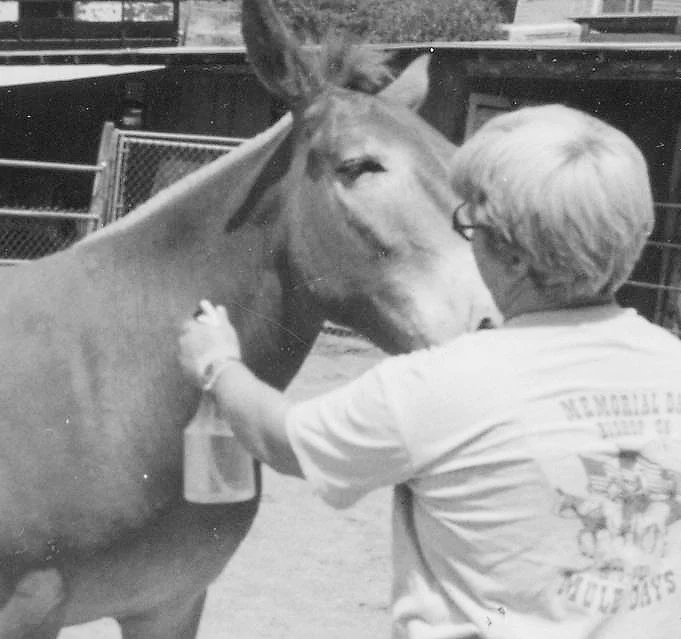Winning the Flyspray Battle
By Susan Dudasik, Salmon, ID - Originally published in the November 2002 issue of Mules and More
With all the concerns about the West Nile virus affecting horses and mules, now’s a good time to help your mule or donkey overcome his fear of the ominous flysprayer.
WINNING THE SPRAYER Bottle war doesn’t have to be a knock-down battle of wills. Photo by Susan Dudasik
The game of flyspraying has been played by equine and human since the beginning, and man has become quite creative at accomplishing his mission. Just look in the flyspray section of any tack shop. There you’ll find shelves of sprays, wipes, roll-ons and ointments, all claiming to keep those pesky flies and mosquitoes off your mule. There are even fancy flysheets, facemasks and ear covers to help in the bug war.
All of these products are great aids for defeating those pesky bugs, that is, as long as your mule will allow you to use them. Unfortunately many mules have convinced their owners the flysprayer contains a ‘mule-eating’ mist that must be avoided at all costs. The second the mule sees the sprayer he pulls back or starts running in circles on the lead rope. Because of this behavior, many owners have resorted to twitches, blindfolds and tying up a front leg, just to get mulie sprayed. These methods all work eventually, but there’s an easier way to accomplish this mission.....it just takes time, patience and understanding.
Most mules are very tolerant of the things we do to them, and if introduced properly, they’ll accept flyspraying also. Usually mules become frightened of the spray because we have assumed they know what it is. The typical scenario is like so: handler ties mule to rail or cross-ties, then without warning, points the sprayer at mule’s neck, usually on the direct stream, not the mist, and sprays. Mule is startled and jumps back, pulling on the rope. Handler yells at mule for pulling. The mule becomes confused and within seconds, a vicious cycle has begun, and the handler declares the mule is afraid of flysprayers.
To counteract this situation, use an empty spray bottle, then with only a halter and lead rope on, put the mule in a small corral or large stall......Don’t Tie Him Up! Stand next to his shoulder and show him the sprayer; let him sniff and touch it. Then hold the bottle at arm’s length in front of him and make a hissing sound. Don’t spray it. If your mule backs up, go with him. When he stops, bring him forward and repeat the hissing. Watch his body language. If he relaxes for a split second, praise him. Continue until he begins relaxing, stands still, and lets you rest the sprayer on his body.....repeat the process on the other side.
When he stands with the bottle at his shoulder, start on the rear. Stand close to his shoulder, facing backwards. Keep his head tipped toward you....this puts you in the safety zone. By pulling on the halter, all your mule can do is run around you in a circle. Hold the sprayer at arm’s length, away from his side, make the hissing sound and begin bringing it closer. He will most likely jump forward, trying to escape. Pull his head close and let him run in a tight circle around you. Alternate the hissing sound with words of calming encouragement. When he stops, praise him with your voice or a treat. Continue until he stands; repeat the process until your mule relaxes as you hiss and rub the sprayer over his back, rump and legs. If he kicks at you get professional help! Never tolerate a kicking mule! Remember to do this on both sides of your mule.
IT JUST Takes time, patience and understanding. Photo by Bev Craigmile
When he stands calmly while you do this it’s time to add the water. At this point it’s cheaper to use water instead of costly flyspray, since you will be using a lot of it. Make sure the sprayer is set for mist, then repeat the above process. Show him the sprayer, then begin spraying about three feet from his nose. Talk to him as you spray closer to him. Praise him as the mist hits his chest. If he pulls back, go with him. After he stops, bring him forward and try again. Don’t lose your temper. Continue until he stands....do this on both sides. Use the same process for the hindquarters. If he wants to run around, keep his head tucked into you and let him. He’ll soon tire. Keep spraying. When he stops, praise him. Work at it until your mule will stand with the lead rope draped over your arm. Only when he will stand like this should you attempt to spray him when tied, never before.
A few words of caution: never spray your mule’s face as it might get in his eyes. Also, be careful around his ears, you wouldn’t want flyspray running down your ears, neither would he. It’s best to simply put some flyspray on a towel and wipe it on.
Depending on your mule, the desensitizing process can take a few days or weeks, but you’ll benefit in the long run. Just be patient and go back to the basics.


